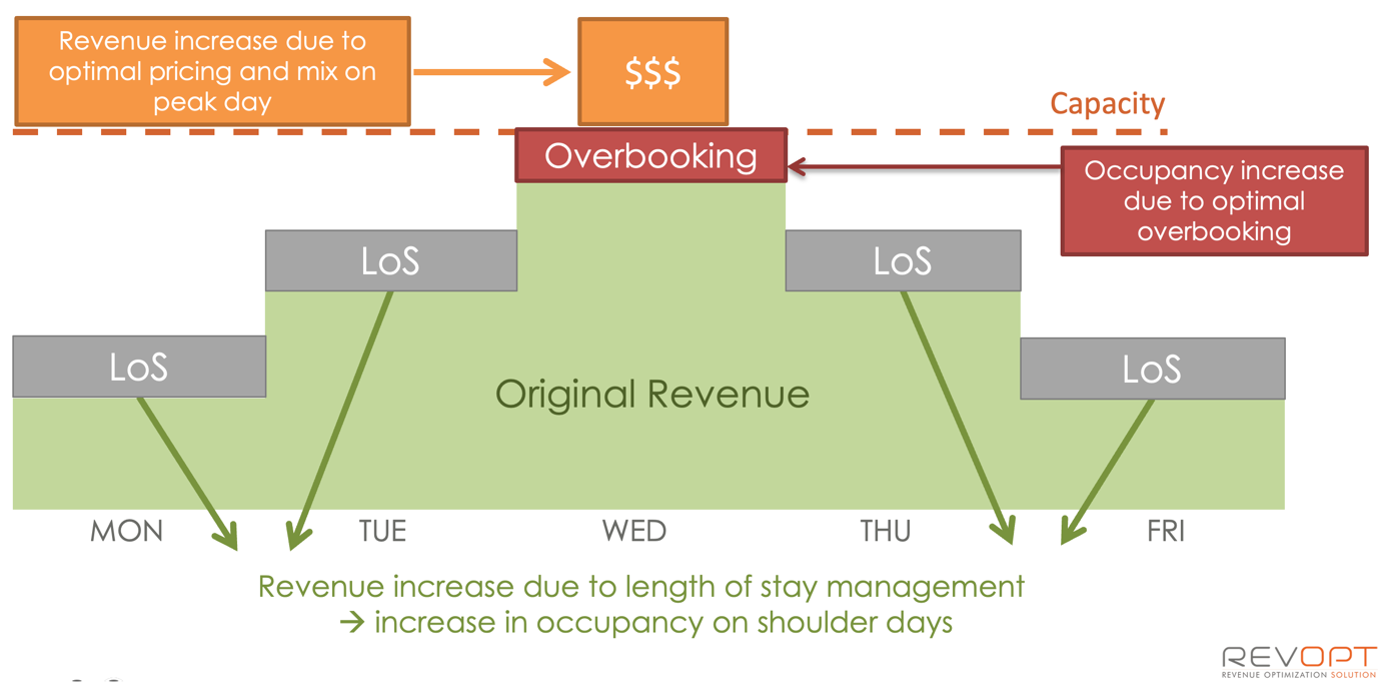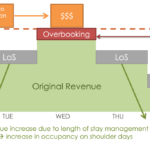Blog

As a hotel, we have a fixed inventory available for sale. How do we make sure that we sell that inventory to the right segment that is going to bring us the most revenue? We do this through capacity control.
Not Just Increasing Rates
Revenue management is not about charging the highest rate. For example, hotels can earn far greater revenues and profits over peak periods by increasing the average length-of-stay of their guests, rather than by increasing their rates.
Consider a hotel where the rate is 225 $ per night. Further, suppose the hotel is frequently sold out on Tuesday and Wednesday nights, but has empty rooms on Monday and Thursday night.
The hotel may be able to increase its rate to 285 $ per night and still remain sold out on Tuesday and Wednesday, but it earns greater profits if it can accept one more guest that will arrive on Tuesday and stay through Thursday night, paying 225 $ per night.
Whereas the guest in the first scenario might stay two nights and pay the hotel 570 $, the guest who stays through Thursday night fills an empty room on Thursday and pays the hotel 675 $.
Length of stay controls, combined with precise overbooking, can significantly increase the occupancy of “shoulder dates” near the peak, overall room nights, revenues and profitability.

FPLOS Controls
One way to control capacity is to use length of stay (LOS) controls. Length of stay controls determine which lengths of stay will result in the most revenue for the hotel and limit the allowed bookings to guests who are planning to stay for only those number of nights.
Full pattern length of stay (FPLOS) controls for hotels can contribute 2-3% additional revenues over rate management programs alone, without incurring additional costs for the hotel. FPLOS controls can be optimally interpreted for Min-Max / CTA control structures.
FPLOS controls allow a hotel to accept a discount rate up to a peak period, say 1 and 2-night length of stay, not allowing stays at this discount rate for the peak, but then again open up this discount rate for longer lengths of stay, thus improving occupancy on the shoulder days and increasing overall revenues.
In addition, hotels incur costs such that, at the same rate, a multiple-night reservation will generate more profits than single-night reservations.
The results are increased revenues and profits from optimally matching the forecast of future bookings against the available supply of rooms using FPLOS.
Benefits:
Permits the hotel to accept the best business mix, increasing RevPAR.
Results in significant increase in the occupancy on shoulder nights for an overall increase in revenue.
Noticeable increases in the average length of stay over peak nights.
Implementation:
When minimum and maximum Length of Stay controls are in place, guests who attempt to book for stays that are too short or too long may be told that there is no availability in the hotel.
It is important to understand that “no availability” does not mean you have no rooms available. For example, your Property Management System might show that 10 rooms are still available for a Wednesday night, but because you have a 2 night minimum length of stay restriction on that Wednesday, a search for a 1 night stay on Wednesday will show no availability. The room therefore stays reserved for any customer who may come along that wants to stay for a longer length of time.
Guests should not be told that Length of Stay controls are in place because they might book for longer than they mean to actually stay, and then cancel the additional nights.
The correct LOS controls have to be selected while dealing with multiple pricing across various segments, daily rate changes, changing inventory and a long period of time to consider. As you can well imagine, it is difficult for any Revenue Manager to control this manually on a daily basis. That’s why automated Revenue Management Systems become a very important tool to assist you in revenue optimization.
Length of Stay controls can be beneficial to a hotel in multiple ways. They permit the hotel to accept the most profitable business mix which increases its RevPAR. Length of Stay controls also result in significant increases in the occupancy on shoulder nights for an overall increase in revenue and are responsible for noticeable increases in the average length of stay over peak nights and this is possible only through implementing an automated revenue management system.
Subscribe & Follow
Recent Tweets
Recent Posts
-

Unlocking Profitability Through Revolutionary Revenue Management: A…
December 15, 2023 -

Why is it important to segment your…
November 30, 2023 -

Full pattern Length of Stay controls increase…
September 26, 2023 -

Achieving the Right Mix of Strategic &…
January 11, 2019 -

Better Budgeting Through Revenue Management
December 21, 2018
Facebook Posts
getRevOpt
Go beyond organic to Expenential Growth
BRING IN THE EXPERTSWhat makes Revopt Unique?
Our unparalleled services helps hotels, chains and management companies develop collective
knowledge of revenue management and upskill their teams to drive exponential revenue.
-
Exponential Revenue
GrowthRevOpt helps you to go beyond organic to Exponential Growth by unlocking the true revenue potential to achieve optimal performance.
-
Automated Revenue
Management SystemCustom tailored to your exact needs. Increased revenues 6%-18%. Multiply profits in as little as 15 minutes per day. Outperform competitiors by 36% or more.
-
Long-term Profitability
& Asset ValueTailor made revenue optimization solution to create a sustainable growth strategy to increase profitability & long-term asset value.
-
Expertise with
unparallelled ServicesRevOpt best industry practices, proven techniques, latest trends & strategies that help hotels to challenge the status quo & outperform the competitors.
